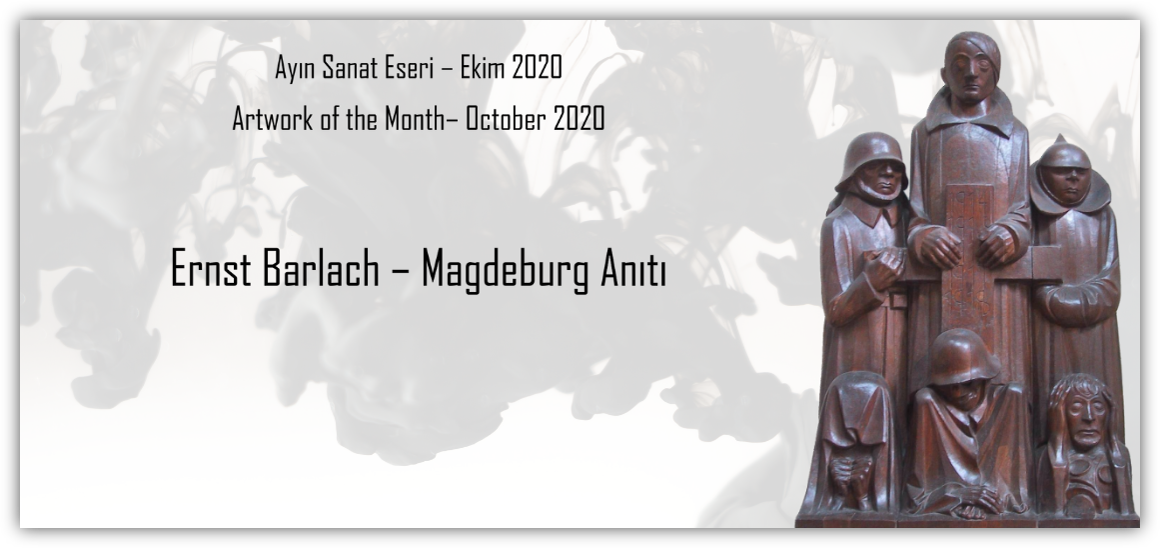Bu ay #GüvenlikPortalı’nın kapak eseri, Alman sanatçı Ernst Barlach’ın 1929 tarihli heykeli olan Magdeburg Anıtı, (Magdeburger Ehrenmal).
Barlach, I. Dünya Savaşı öncesi savaşı destekler bir eğilim sergilemekteydi ve bu eğilimi, onu savaş başladığında gönüllü olarak savaşa katılmaya sevk etti. Ne var ki üç ay sonra sağlık sorunları nedeniyle terhis edildi. Terhis edilişinin ardından savaş karşıtı ve pasifist bir birey oldu. Fikir ve tutumlarındaki bu değişikliği eserlerine de yansıttı. Özellikle Gotik/Nordik sanatının etkilerini taşıyan heykelleri, insanın çektiği acıları bedensel olarak görselleştirmektedir.
Magdeburg Anıtı ise, Barlach’ın Magdeburg şehrinin 1. Dünya Savaşı’nı anlatan bir anıt sipariş etmesi üzerine hazırladığı bir anıttır. Tüm savaş anıtları gibi, savaşta gösterilen kahramanlıkları görselleştirmesi beklenirken; bu sanat eseri, savaşın yarattığı korku içerisinde bekleyerek acı çeken askerleri gösterir. Sol altta yer alan yüzünü kapatmış figür savaşta eşini kaybetmiş bir kadındır. Sağ alttaki dehşet içerisinde kulaklarını kapatan erkek figürü ise Barlach’ın kendisidir. Heykelin kahramanlık yerine savaşın acıları üzerine odaklanması, Nazilerin hoşuna gitmemiştir ve heykel kaldırılmıştır. 2. Dünya Savaşı sonrasında ise Magdeburg Katedrali’ne geri yerleştirilmiştir.
Barlach, Nazi Almanyası’nın hüküm sürdüğü bir dönemde, kendisi gibi Nasyonal Sosyalist Alman İşçi Partisi’nin karşısında olan bütün sanatçılarla birlikte baskılara ve saldırılara maruz kalmıştır. Eserleri müzelerden çıkartılmış, kamusal alandaki heykelleri toplatılıp yok edilmiştir. Birçok meslektaşı Almanya’yı terk ederken, Barlach bütün maddi imkânsızlığa rağmen ülkesini terk etmemiş ve II. Dünya Savaşı’nın başlangıcının hemen öncesi olan 1938’de hayatını kaybetmiştir.
***
This month’s artwork of the #SecurityPortal is German artist Ernst Barlach’s 1929 sculpture Magdeburg Commemorative Sculpture, (Magdeburger Ehrenmal).
Barlach had used to support the idea of war prior to World War I, and this tendency prompted him to voluntarily join the war following its outbreak. However, he was discharged in three months due to serious diseases that he was suffering from then. After the discharge, Barlach turned into an anti-war and pacifist individual. He depicted this change in his ideas and attitudes in his artworks. His sculptures, especially influenced by Gothic/Nordic art, visualize humans in pain that can be physically seen.
The Magdeburg Commemorative Sculpture was made to order from the city of Magdeburg by Barlach. As with all war monuments, it was expected to visualize the heroism shown in the war; however, this artwork shows soldiers suffering and waiting in fear caused by the environment of the war. The figure in the lower left depicts a woman whose husband has passed away in the war. The other figure, on the other hand, covering his ears in fear in the lower right corner is none other than Barlach. In the composition of the sculpture, he focuses on tragedies of the war rather than on ‘heroism’. As a result, the Nazis, extremely disturbed by the situation, ensure that the sculpture was removed. It was placed back in the Magdeburg Cathedral after World War II.
During the reign of Nazi Germany, Barlach was exposed to pressure and attacks along with all the other artists who opposed the National Socialist German Workers Party. His artworks were removed from museums, and his public sculptures were collected and destroyed. While many of his colleagues left Germany, Barlach stayed in his country despite all financial difficulties and he died in 1938, just before the outbreak of World War II.

